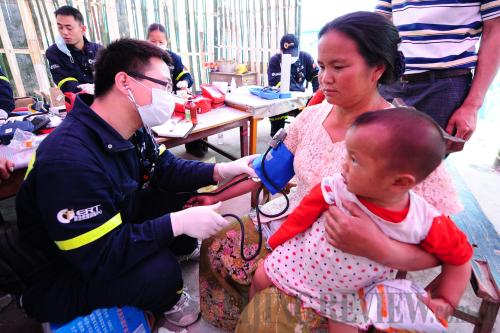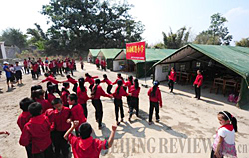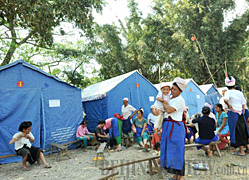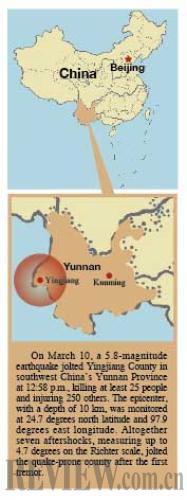|
 |
|
HELP FROM AFAR: Volunteers from Beijing provide medical services to quake survivors in Yingjiang County (QIN QING) |
The provincial earthquake bureau activated its emergency plan. Two teams of rescuers equipped with necessary appliances were sent to the disaster area from provincial capital Kunming and Dali.
Militia, armed police and border patrol troops in Dehong also took part in rescue operations.
The first group of 20 rescuers arrived on the scene about 20 minutes after the quake struck. Ten minutes after they arrived, they pulled a survivor out of the debris.
In addition to digging for victims, rescuers also transferred survivors to safe places, delivered emergency supplies and maintained social order.
In the meantime, the provincial health bureau sent medical teams to the quake-stricken county, bringing medicine with them. Almost all the medical workers sent to Yingjiang had disaster relief experience in the 8.0-magnitude Wenchuan earthquake in neighboring Sichuan Province in May 2008.
Yingjiang's center for disease control and prevention started disinfection and epidemic prevention right after the earthquake, said Zhou Yun, Deputy Director of Yunnan Provincial Health Department.
Usually, disinfection and disease prevention will continue for one to 18 months after a disaster, Zhou said.
 |
 |
|
TENT SCHOOL: Students in a primary school in Yingjiang County play outside their tent classrooms on March 14 (QIN QING) |
SAFE AGAIN: Survivors in Lameng Village near the epicenter of the earthquake are accommodated in a temporary settlement (CHEN HAINING) |
On March 11, the Central Government allocated 55 million yuan ($8.4 million) for relocating and settling local residents, providing living subsidies and offering condolence payments to those who lost family members in the quake.
The next day, the Ministry of Finance said it had allocated 50 million yuan ($7.6 million) for infrastructure emergency repair in Yingjiang.
The Ministry of Civil Affairs sent 5,000 tents, 10,000 quilts, 10,000 coats and 62 tons of cloth to the disaster area, while the provincial civil affairs department also sent 2,000 tents, 3,000 quilts, 3,000 coats and some cloth.
The Red Cross Society of China, Red Cross societies of Hong Kong and Macao and other provinces of China also donated tents, quilts, coats, emergency family kits and money.
Yunnan Provincial Civil Affairs Department said, as of noon on March 12, it had received 37 million yuan ($5.6 million) in cash and some emergency supplies from the public.
As of the evening of March 13, 16.7 million yuan ($2.5 million) had already been distributed to affected residents in Yingjiang, said Shang Labian, deputy head of the county.
Shang said 8,999 tents had been set up, many emergency supplies had also been distributed, and the basic living needs of survivors had been met.
Reconstruction
Yingjiang has started to plan on post-disaster reconstruction.
Safety assessment of public buildings in Yingjiang, such as schools and hospitals, began on March 13.
The assessment team under Yingjiang's disaster relief headquarters consists of 85 engineering experts.
The results of the assessment are the basis for ensuing reconstruction, said Li Wenqiang, deputy head of Yingjiang's Construction Bureau.
Safety assessment of residential homes would be carried out after key public buildings were appraised, said Li. All loss evaluations are expected to be completed within one or two weeks, he added.
For residential homes assessed to be safe, the county would encourage their owners to move back, said Li.
On March 10, a 5.8-magnitude earthquake jolted Yingjiang County in southwest China's Yunnan Province at 12:58 p.m., killing at least 25 people and injuring 250 others. The epicenter, with a depth of 10 km, was monitored at 24.7 degrees north latitude and 97.9 degrees east longitude. Altogether seven aftershocks, measuring up to 4.7 degrees on the Richter scale, jolted the quake-prone county after the first tremor.

| 